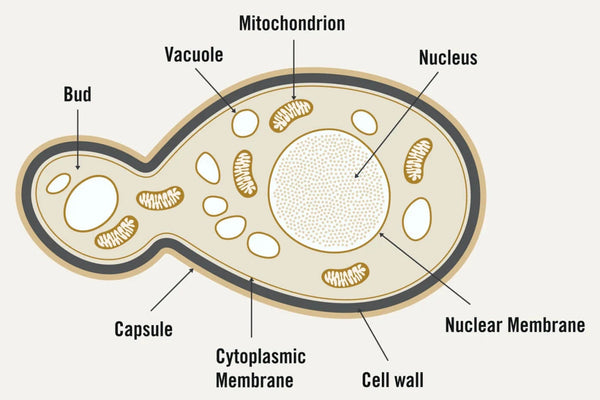The Structure of a Yeast Cell
Aug 16, 2023
Yeast is a single-celled organism which feeds on sugar, producing alcohol, carbon dioxide, heat and flavour compounds in return. There are many species of yeast existing in nature but the species used primarily in distilling is saccharomyces cerevisiae.
So, what does a yeast cell look like?

Yeast Cell Diagram
Breakdown of the Yeast Cell Diagram:
The yeast cell structure comprises eight key elements, as shown in the diagram:
- Capsule. The outer part of the cell wall.
- Cell wall. The protective layer surrounding the cell which gives the cell structure.
- Cytoplasmic membrane. The membrane controls the molecules and compounds that come in and out of the yeast cell.
- Bud. The new “daughter” cell, that eventually splits off from the original “mother” cell.
- Mitochondria. The “power house” of the cell where respiration occurs.
- Nucleus. The part of the cell containing DNA.
- Nuclear membrane. The protective layer around the nucleus that controls flow of material in and out of the nucleus.
- Vacuole. The sac inside the cell contains water and other liquids.
The Role of Yeast in the Scotch Whisky-Making Process
In the Scotch whisky-making process, it is only when yeast is added to the wort that fermentation takes place. The yeast strain used in whisky fermentation plays a crucial role in shaping the whisky's flavour, making the choice of yeast highly important. Under anaerobic conditions (that is, without the presence of oxygen), yeast metabolises sugar, producing alcohol as a by-product. Many congeners (aroma and flavour compounds) are generated during fermentation, so it is a vital contributor to the final aroma and taste of the whisky.
If you want to geek out further about fermentation, why not join the Diploma in Single Malt Whisky either online or in-person? In our most advanced whisky course, you’ll take a deep dive into all things single malt over 7 modules. 15 samples are included for tasting and practical sensory assessment. The certified whisky connoisseur within you is waiting.



